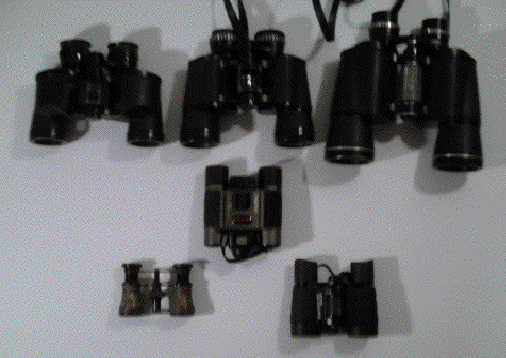
Binocular Basics
When folks start considering amateur astronomy, the first thing they think of are telescopes. That can be an expensive proposition. Binoculars are a great alternative to telescopes, and actually far more useful... as well as not nearly as costly.
But the question really comes down to what type of binoculars to get.

Not A New Idea
Believe it or not, using binoculars for astronomy goes back to the 19th century. At that time, what we call binoculars were really twin Galilean telescopes, usually defined as field glasses or opera glasses. It was in 1888 that science popularizer and journalist Garrett P. Serviss wrote the popular "Astronomy With An Opera Glass", a book that remained in print until 1961. Mr. Serviss explained that opera glasses provided an inexpensive alternative to telescopes...
"...because it is popularly supposed that only the most powerful telescopes and costly instruments of the observatory are capable of dealing with them. "
What Mr. Serviss proposed was an inexpensive alternative to telescopes, which at the time were quite pricey. Opera glasses were much cheaper in comparison. They had one fault, however - they had a narrow field of view. This means that the amount that could be seen was pretty much straight forward, usually less than a 25 field.
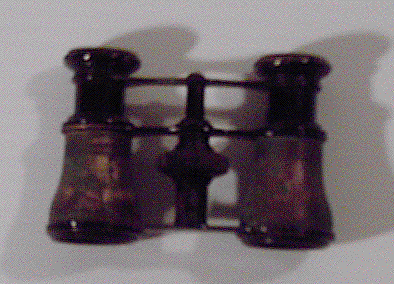
3 x 25 Lamier Opera Glasses, circa 1915
(and they still work!)
It was as the 20th century rolled along that improvements to these handheld instruments really took off (in fact, one design actually went back to the mid-19th century. More in a minute). Soon, fairly decent optics could be had by most people.
Magnification & Types
Binoculars are identified by a set of numbers found somewhere on their case, that looks something like this; "7 x 50". When shopping for binoculars, it's important to know what all those numbers mean, so let's break it down. The first digit, in the case of our example 7, is the magnification. While 7 doesn't seem like much, it is actually a good magnification when looking at rich star fields or nebulae. The second number, in this case 50, is the aperture of the primary optics in millimeters (to my fellow Americans, you'll find that astronomy is dominated by metric). Aperture is very important - the greater the aperture, the more light is caught, and therefore the fainter the objects that can be seen. While it may be tempting to buy binoculars with greater than 10 x, it's really not that great an idea. Higher magnification means narrower field of focus and soon you find that you need to invest in a tripod to mount them. Think low power, 7 to 10x.
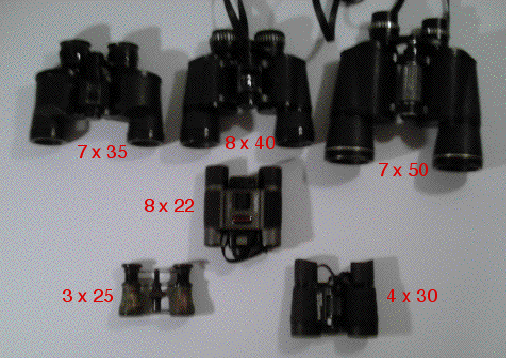
Today, binoculars can really be broken into three main optical categories - Galilean (think field or opera glasses), Porro and Roof. Incredibly, Galilean binoculars are still around, both in the form of field glasses and opera glasses.
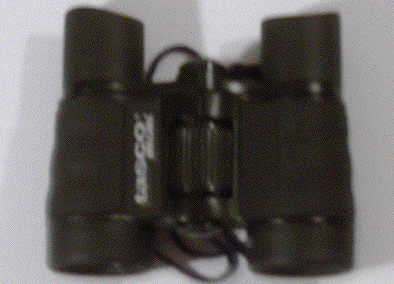
4 x 30 Field Glasses
Unfortunately, while optically superior to the classic opera glasses, they still possess a narrow field of view (however, I enjoy using them in conjunction with that classic book mentioned earlier and imagine myself doing sidewalk astronomy under gas light, perhaps in 1900 Manhattan. And at just 4x, some items look actually rather interesting, such as the Hyades, an open cluster that makes up the head of Taurus the Bull; it actually looks like an open cluster. But I digress).
When most people think binoculars, the first design they think of is Porro prism.

7 x 35 Porro Prism Binoculars
Porro prism binoculars are the most common design today. As previously hinted at, the design actually goes back to the mid-19th century. The size shown above, 7 x 35, is considered by many to be too small for stargazing. However, I've found that they are not bad and better than no binoculars at all. The best sizes for Porro prism binoculars are 7 x 40 to 7 or 10 x 50. Any larger and they tend to get heavy and harder to steady. Incidentally, I still have a pair of 7 x 35 K-Mart binoculars that I've had since my childhood; they were given to me in 1973 and are just as good today as they were then.
The next binocular design is a bit more recent and growing in popularity, the Roof prism design.
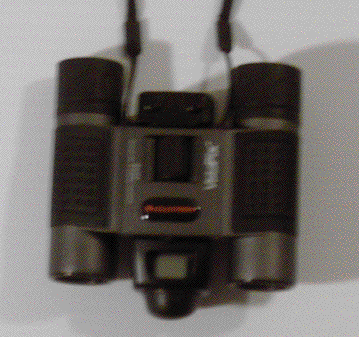
8 x 22 Roof Prism Binoculars
(with built-in digital camera)
The Roof prism design offers one big advantage over Porro, and that is they are compact. Some of the smaller designs, 8 x 22, for instance, can simply be folded and stuffed into your pocket. Their primary disadvantage is cost, since they tend to be more expensive than the Porro design due to their complexity (and a personal note. I've found that images in Roof prism binoculars tend to be a little darker. This is probably due to the complicated path that light takes within those prisms. With each bounce, more light is lost). A good size to start with is 8 x 40, as this size will give you the best compromise of aperture and costs.
Other Considerations
A word about coatings. Many binoculars today are sold with UV coatings. Unless you plan on using these as multi-purpose binoculars, say for bird watching... or people watching..., this isn't really necessary. Also, the ruby or red coatings are becoming increasingly popular as a means to control glare. Again, if you plan on using them strictly at night, then this is something that really isn't necessary as well. Most coatings are applied to help reduce the amount of light lost. Look for fully coated when possible, and if you are willing to go that extra mile (i.e. spend more), go with fully multicoated.
Wrapping It All Up
I could go on and on about binoculars, but there are folks out there who have done a much better job than I. First, I want to point you in the direction of my friend, Dr. Mike Reynolds, book, "Binocular Stargazing". This is a great book, and I'm not just saying that because I did some of the illustrations. He covers, in much better detail, what to look for in binoculars as well as what to observe. Highly recommended.
Another good book is Phil Harrington's "Touring The Universe Through Binoculars". He also has a great page at Astronomy.com, "Phil Harrington's Binocular Universe".
A classic in the field is Ernest Cherrington's "Exploring The Moon Through Binoculars". Originally published in 1969 (you might recall that there was this little program called Project Apollo and thus this huge interest in the Moon), it is still highly regarded today.
The Utah Valley Astronomical Society has a great page with additional binocular astronomy links.
So, if you decide that it's time to move from naked eye observing to a little more magnification, consider this alternative to telescopes. It might just be your first step into this amazing hobby we know as amateur astronomy.
This page assembled with TextEdit on Macintosh OS X version 10.4.6... believe it or not.